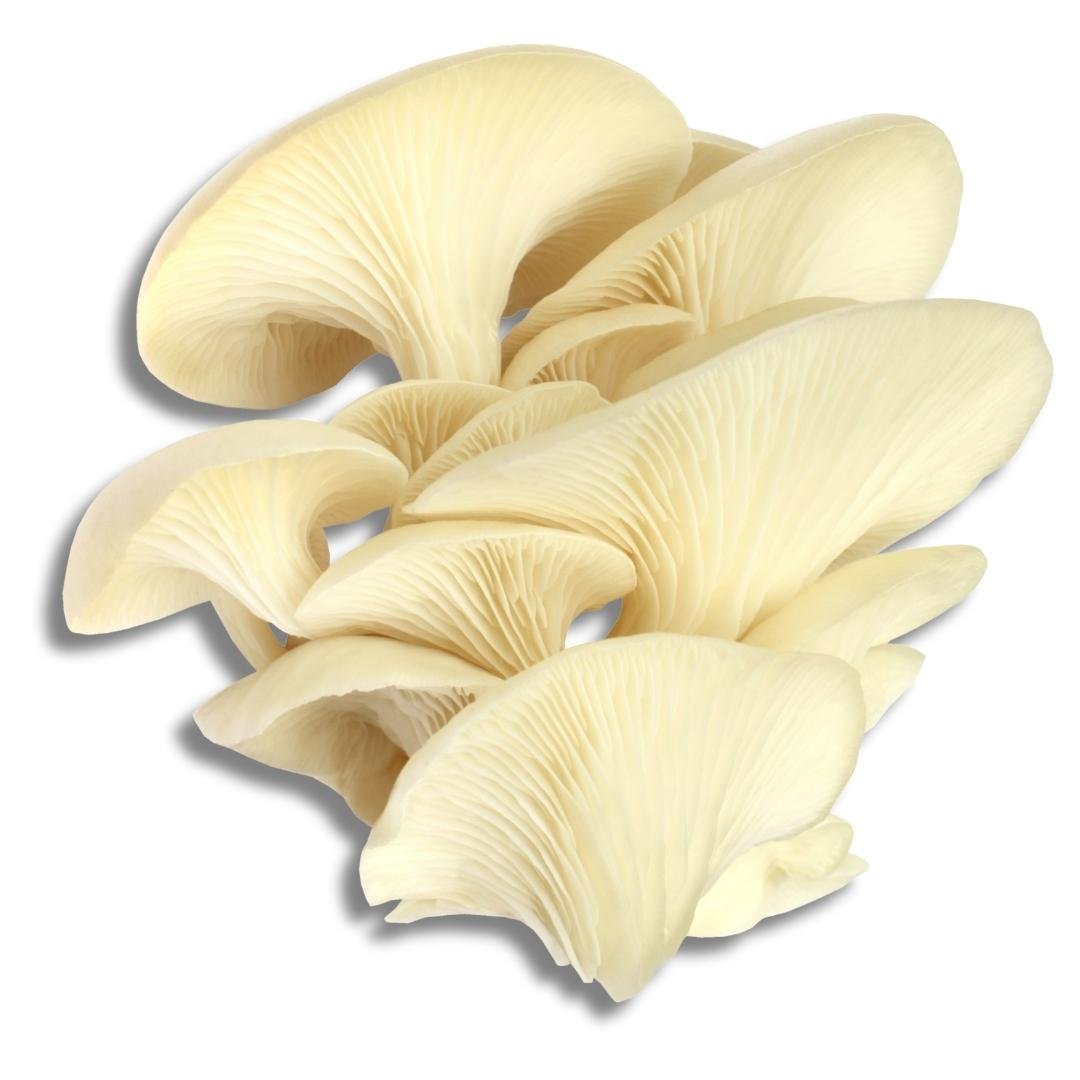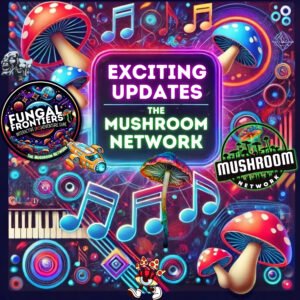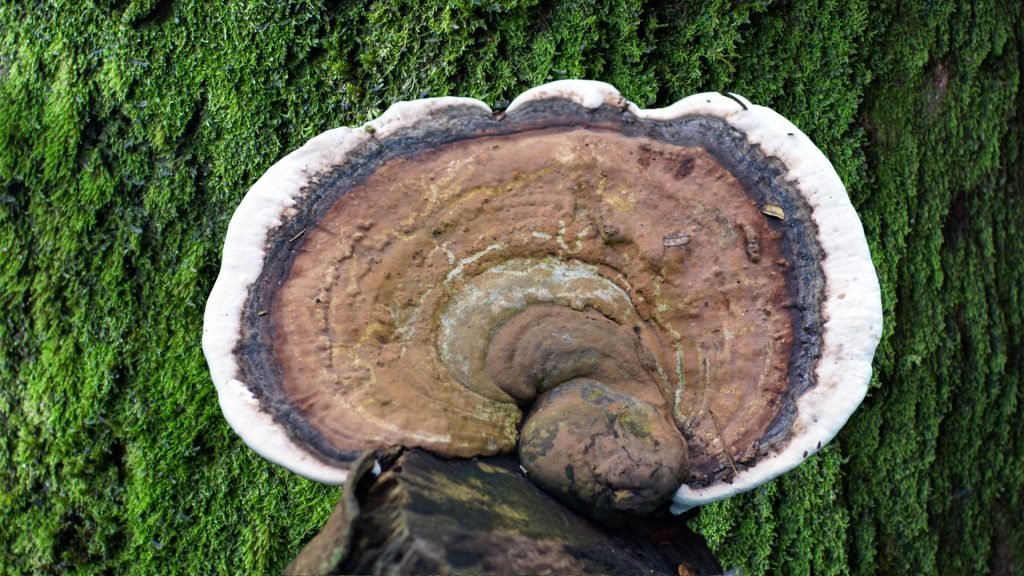Welcome, fungi enthusiasts and culinary adventurers, to the world of the White Oyster mushroom! As we explore Pleurotus Ostreatus, let’s immerse ourselves in its culinary versatility and ecological significance, celebrating the wonders of mycology.
SCIENTIFIC NAME:
(Pleurotus Ostreatus)
COMMON NAME(S):
White Oyster Mushroom | Oyster Shelf | Tree Oyster Mushroom | Hiratake
I-NAME:
GWO
Founding Mycologist/Discovered By:
-Unknown-
If you have information, please help us enrich our database!

RECOMMENDED TEMPERATURES
Colonizing Temps:70° – 75°F | Fruiting Temps:50° – 65°F |
SPORE COLOR:
LILAC-GREY to WHITE
Dive into the captivating realm of White Oyster mushrooms, renowned for their delicate flavor and impressive growth. This versatile fungus is a favorite among chefs and cultivators alike, offering a blend of gastronomic delight and ecological benefits.
DESCRIPTION:
White Oyster mushrooms are recognized by their broad, fan-shaped caps, typically white to light grey in color. They have short, stubby stems and grow in shelf-like clusters on dead and decaying wood. Their gills run down the stem, adding to their distinctive oyster-like appearance.
INTENDED USES:



HABITAT AND DISTRIBUTION:
Common in temperate and subtropical forests, Pleurotus Ostreatus thrives on dead hardwood. They are found worldwide, especially in North America, Europe, and parts of Asia.
ECOLOGICAL ROLE:
As decomposers, White Oyster mushrooms play a vital role in breaking down organic matter, recycling nutrients back into the ecosystem and supporting forest health.
GROWTH AND CULTIVATION:
One of the easiest mushrooms to cultivate, they grow rapidly on a variety of substrates, including straw and coffee grounds. Their robust nature makes them ideal for novice growers.
No posts found!
HISTORICAL & CULTURAL INFO:
The White Oyster mushroom has a rich history in traditional Asian cuisine and medicine. In recent years, its popularity has surged in the West, both as a gourmet ingredient and a model organism for mycological studies.
GENETIC LINEAGE/HISTORY:
While the exact lineage of Pleurotus Ostreatus is still under research, it’s known to be closely related to other oyster mushroom species, each with unique culinary and medicinal properties.
No posts found!
CHEMICAL COMPOSITION:
Rich in proteins, vitamins, minerals, and antioxidants, White Oysters are a nutritional powerhouse. They also contain compounds thought to reduce cholesterol and boost immunity.
MEDICAL PROPERTIES (if applicable):
Studies suggest potential benefits in cardiovascular health, diabetes management, and immune support. Their beta-glucans content is particularly noted for immunomodulatory effects.
CULINARY USES (if applicable):
Known for their subtle flavor, they’re versatile in cooking – stir-fries, soups, and as meat substitutes. They absorb flavors well, making them a favorite in diverse cuisines.

CAUTIONS & WARNINGS:
While generally safe, some may experience allergies. It’s crucial to source White Oysters from reputable suppliers to avoid confusion with look-alike species. It is important to consult a doctor before consuming any mushrooms, especially if you have a pre-existing medical condition or are taking medication.
FINAL CONSIDERATIONS:
Explore the versatility of White Oysters in our 🍄 Marketplace. Whether you’re a gourmet chef or a home cultivator, these mushrooms offer a world of possibilities.
Don’t forget to check out the 🍄 Mushroom Network’s Marketplace to see what’s available. But hurry, our shelves are constantly evolving, and you wouldn’t want to miss out on this wonderful mushroom. Join our growing network of Patrons, Genetics, and Mycologist Vendors only on the 🍄 Mushroom Network!
No posts found!
No posts found!
FAQs:
Sautéing or grilling brings out their flavor; they’re also great in soups and stews.
Absolutely! They’re beginner-friendly and grow well on substrates like straw.
They help decompose wood, recycling nutrients and supporting forest ecosystems.
Yes, they’re a fantastic meat alternative, rich in protein and nutrients.
While promising, always consult a healthcare professional before using them for medicinal purposes.
MYCO-CLOSINGS:
Thank you for embarking on this mycological journey with us! Remember, in the world of mushrooms, White Oysters remind us to savor simplicity and nurture nature. Keep exploring and stay fungi-fantastic!
Related Articles:
White Oyster (Pleurotus Ostreatus)
Welcome, fungi enthusiasts and culinary adventurers, to the world of the White Oyster mushroom! As...
Read More...Unearthing the Potential of the Black Pearl Oyster Mushroom
In the mycological sphere, the Black Pearl Oyster Mushroom, scientifically known as Pleurotus Ostreatus, is...
Read More...The Galactic Map of Mushrooms: Understanding Spore Prints
About This Article: This is where you can leave notes or details that only ADMINS...
Read More...King Blue Oyster (Pleurotus Ostreatus)
Scientific Name: Pleurotus Ostreatus COMMON NAME(S): King Blue Oyster | Blue Oyster | Blue Pearl...
Read More...Other Mushroom Species To Research:
King Blue Oyster (Pleurotus Ostreatus)
Scientific Name: Pleurotus Ostreatus COMMON NAME(S): King Blue Oyster | Blue Oyster | Blue Pearl...
Read More...Cauliflower Mushroom (Sparassis Crispa)
SCIENTIFIC NAME: (Sparassis Crispa) COMMON NAME(S): Cauliflower Mushroom | Hanabiratake | Western Cauliflower Fungus |...
Read More...Black Trumpet (Craterellus Cinereus)
Greetings, fungal aficionados and nature lovers! Today, we embark on a fascinating exploration of Craterellus...
Read More...Bleeding Fairy Helmet (Mycena Haematopus)
Greetings, fungal aficionados and curious minds! Today, we delve into the enigmatic world of Mycena...
Read More...Other Recommended Reads:
TMN News Announcement 07/03/24
https://youtu.be/UGgDgbonkP8 TMN News Announcement Exciting Updates from The Mushroom Network! Hello, Myco-Patrons! We have been...
Read More...Fungal Pharaohs: Mushrooms as Gods in Ancient Societies
Imagine a world where mushrooms aren’t just food or medicine, but gods. Throughout history, ancient...
Read More...Nameko: Health and Healing: The Medicinal Potential of Nameko Mushrooms
When it comes to the spectrum of medicinal mushrooms, Nameko holds a distinctive place. Treasured...
Read More...An Exploration of Project Aurora’s PARS Enlightenment Ritual: Mindful Use of Mushrooms for Spiritual Connection
About This Article: Disclaimer: This article provides an educational overview of the PARS Enlightenment Ritual...
Read More...Whoa there, Spore Sport! 🍄 Looks like you’re not logged in yet. Don’t you know what you’re missing? MYCO-CREDITS! Imagine all the fungal fun you could have. It’s like finding a Morel in May and not picking it. Tragic, right? Log In or Become a Myco-Patron and start racking up those credits. It’s more rewarding than finding a mushroom in your backyard! 🌟🏡
















